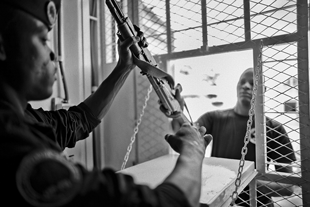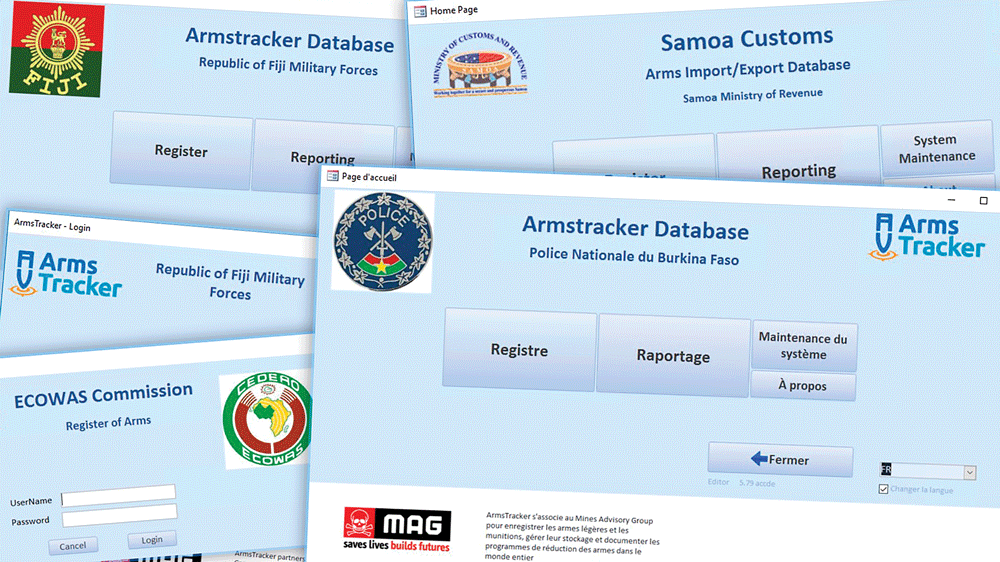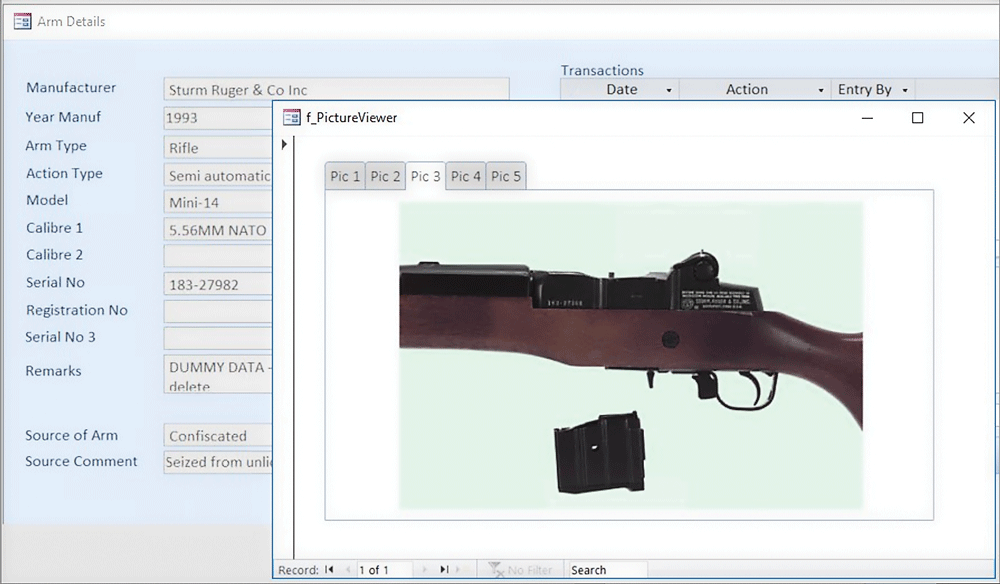A Pressing Need: Decades of Agreement, Few Results on Arms Record-Keeping
Decades of Agreement, Few Results on Arms Record-Keeping
CISRThis article is brought to you by the Center for International Stabilization and Recovery (CISR) from issue 25.2 of The Journal of Conventional Weapons Destruction available on the JMU Scholarly Commons and Issuu.com.
Recent developments in computerized record-keeping for state-owned arms, ammunition, and explosives now offer simple, affordable solutions in the lowest-capacity environments. A global partnership between Mines Advisory Group (MAG) and the developers of ArmsTracker software promises to break a twenty-year logjam that, until now, has denied comprehensive, affordable weapon and ammunition record-keeping systems to states in greatest need.

Issuing a registered arm in Burkina Faso, 2015. Image courtesy of Sean Sutton/MAG.
Beginning in the 1990s, key agencies in humanitarian mine action (HMA) gradually broadened their missions to include weapon and ammunition management (WAM). For example, MAG initially cleared stockpiles of illicit and excess arms and ammunition as part of its mine action programs in Angola, Burundi, Cambodia, and the Democratic Republic of the Congo (DRC); helped with safe ammunition storage in Iraq;1 and currently secures and destroys small arms and ammunition in nineteen states in Africa, Asia, Latin America, and the Middle East. MAG increasingly considers these more comprehensive capacity-building frameworks as contributing to armed violence reduction (AVR), alongside a growing focus on complementary engagement at the community level.2
In a prescient policy brief in 2012, the Geneva International Centre for Humanitarian Demining (GICHD) explored “the rationale for this shift from ‘traditional’ mine action to AVR,” noting that “the role of mine action organizations in supporting AVR is invaluable…their relevant expertise, the innovative approaches that they are adopting (e.g., towards community safety), as well as the relationships they have already built with national security sector actors give them unique insight, leverage and opportunity to contribute to AVR.” As a significant incentive for this shift, GICHD observed that “in many contexts the threats to safety and security posed by arms are far higher than threats from mines and [explosive remnants of war] ERW.”3 In a 2019 report, the United Nations Institute for Disarmament Research (UNIDIR) noted that WAM “is becoming a key component of conflict prevention and stabilization strategies, with many conflict-affected and post-conflict States in Africa increasingly implementing a range of WAM activities.”4
Data Security
Countries often store some of their most sensitive information in an arms management system. To guarantee data protection, ArmsTracker is installed by the state’s own security and IT experts. A client agency’s data never leaves its premises unless IT staff choose to share limited reports, for example with another state entity. ArmsTracker data is isolated from all other files, with security settings and encryption configured only by the client. No network or Internet connection is required.
Yet in expanding their brief from locating and destroying explosives one by one to destroying mines, surplus arms, and ammunition, and then perpetually securing the storage of millions of weapons and munitions in ongoing daily use, AVR practitioners now face an ever more pressing need. Despite many attempts, no digital record-keeping solution for state-owned arms has emerged to standardize the ongoing management of stockpiles of arms and ammunition in low-capacity countries.5
To fill this gap, MAG is currently launching AVR pilot projects with a potential software solution in Burkina Faso6 and Sierra Leone. ArmsTracker (www.armstracker.org) is a computerized record-keeping solution for state-owned arms, ammunition and explosives, purpose-built for small island and developing nations by the Centre for Armed Violence Reduction (CAVR).7 A registered charity created by faculty from the School of Public Health at the University of Sydney, CAVR partners with MAG and others to provide ArmsTracker at no net cost to qualifying government agencies in countries where the need is greatest.

A collage of ArmsTracker screenshots showing the home or login pages of several installations. Installed with government agencies across the Pacific and Africa, ArmsTracker can be switched to local languages. Image courtesy of CAVR.
CAVR’s first proof-of-concept installation of ArmsTracker was with the government of Samoa, where an eighteen-month pilot project successfully digitized records of the country’s state-owned small arms. The government is now equipped to generate instant status reports in formats consistent with various international instruments including the Arms Trade Treaty (ATT) and the Sustainable Development Goals (SDGs). ArmsTracker installations are also underway with military, law enforcement, border control, and other agencies in Palau, Fiji, and West Africa. In a project funded by the United Nations (UN),8 the Small Arms Division of the Economic Community of West African States (ECOWAS) in Abuja, Nigeria, has installed ArmsTracker in readiness for data input from government agencies across the fifteen member states of ECOWAS.9 Although Arms-
Tracker confidentiality agreements prevent disclosure of arms and ammunition quantities or methods by other than the governments themselves, the small arms to be recorded across these projects number in the hundreds of thousands.
Highly-secure and easy-to-use, ArmsTracker requires only a standalone PC with Microsoft Office to enable accurate, comprehensive record-keeping in local languages. This simple yet powerful software computerizes small arms, ammunition, and explosives record-keeping, storage and destruction, imports, and exports. Every installation is tailor-made for each government agency involved to fit with national and regional laws, to simplify consistency with multilateral agreements such as arms embargoes, anti-terrorism, and transnational crime control instruments, and other relevant international instruments, all to prevent illicit use and diversion of weapons and ammunition and to reduce armed violence. Consultation, customization, and installation is followed by staff and community training. The ambition of CAVR and MAG is to deliver a solution that proves as useful to the AVR and physical security and stockpile management (PSSM) communities as the Information Management System for Mine Action (IMSMA) has been to humanitarian demining.
Tamper Protection
ArmsTracker stores a cradle-to-grave log of every transaction made within the system. This permanently identifies the user responsible for each addition or edit. As the records cannot be deleted, ArmsTracker provides a chain-of-evidence foot-printing system designed to stand up in court. A multi-level permission system restricts access only to users selected by the client.
A tool such as ArmsTracker could be seen as long overdue. In a quarter-century of discussion on the importance of PSSM of conventional arms, effective record-keeping for state-owned munitions has been one of the most persistent recommendations raised. Despite these urgings, military, law enforcement, border control, and other state-owned small arms, ammunition, and explosives are typically undocumented or poorly-recorded in communities most at risk of weapons diversion and armed violence.0 This pressing need for accurate local data is more than just a wish-list item from a bevy of UN and European Union (EU) agencies, think tanks, and NGOs in the global north. From 2012 to 2017, the UN Office for Disarmament Affairs logged more requests from UN Member States for assistance with WAM than any other category regarding conventional arms.11 In 2021, there are still twenty-nine outstanding requests from Sub-Saharan Africa alone for international assistance to improve record-keeping capacity for weapons, ammunition, and explosives12

ArmsTracker stores internationally standardized details of each arm, a tamper-proof history of each transfer, GPS coordinates, and more. Image courtesy of CAVR.
Much has been written,13 including in this publication,14,15 to encourage practitioners and donors to think more broadly—to look beyond the mere collection and destruction of a few illicit or excess arms and explosives identified as the immediate problem, and more toward recording and managing the much larger quantities at risk of diversion and misuse. These are the weapons, ammunition, and explosives held in existing stockpiles. Their large numbers, lack of effective management, and persistent leakage from unsecured storage suggest that disarmament programs will never be enough.
Around the world, countries maintain record-keeping practices for state-owned arms and ammunition via national legislation.16 Governments are very experienced at maintaining these and other public safety processes. The EU records the details of twenty-three million cows from birth to death. India keeps records of 281 million cooking gas bottles, and 1.5 billion motor vehicles are individually recorded worldwide. But in all this, the international community has yet to promote a comprehensive, low-cost digitized record-keeping system for weapons, ammunition, and explosives to help low-capacity states prevent diversion and illicit use, curb armed violence, and comply with international norms.
Partial solutions have been attempted. In the years 2009–2020, the Regional Centre on Small Arms in the Great Lakes Region, the Horn of Africa, and Bordering States (RECSA) deployed its Small Arms Tracing System Software to eight of fifteen member states in support of fifty-one weapons-marking machines. The aim was to permanently identify state-owned small arms and light weapons (SALW).17 From 2017 to 2019, The HALO Trust installed a bespoke system to digitally record the SALW stockpile of the Armed Forces of Bosnia and Herzegovina.18 The UN and other agencies have also maintained computerized records for armed peacekeeping operations, but several seem to have fallen into disuse. More recently, Conflict Armament Research previewed its web-based application for arms record-keeping using hand-held devices in Somalia.19
Such efforts commonly focus on military forces whose specialist units and trained personnel already manage defense matériel with purpose-built asset management systems. Yet a larger need is often felt by less-resourced military, law enforcement, border control, and other state agencies responsible for their own arms and ammunition, along with seized or excess weapons held as evidence or for destruction. In the absence of documented accountability, these are frequently the weapons that leak into criminal and terrorist misuse.
In Africa, key regional agreements such as the SADC Protocol on the Control of Firearms (2001),20 the Nairobi Protocol (2004),21 the ECOWAS Convention (2006),22 and the Kinshasa Convention (2010),23 all of which oblige Member States to digitally record small arms, remain largely unrealized in the absence of simple, suitable software.24 Also lacking from past solutions has been software integration to respond to provisions in the relatively recent ATT.
Major donors including the EU25 have indicated support for such a system. The specifications have already been written. These range from the instructions contained in the UN’s International Tracing Instrument (ITI)26 and the precise detail provided by the UN Office for Disarmament Affairs’ MOSAIC modules,27 to the grassroots handbook for UN disarmament, demobilization, and reintegration (DDR) practitioners that stipulates “a simple database” with “close-up and full-frame photographs…of each piece of matériel.28 ArmsTracker carefully follows all these guidelines.
Each ArmsTracker installation faces significant challenges. Small island states in the Pacific with unarmed police, no military, and few arms and ammunition imports or exports may assign a low priority to addressing arms management. In Africa where the need is much greater, lack of institutional capacity, political and security-related suspicions, the vagaries of international assistance, and above all else, the need to sustain such a system in the long term will always provide hurdles to overcome. With these problems in mind, a simple and affordable, globally standardized software solution with the long-term support of experienced in-country AVR capacity-builders such as MAG will be crucial.
For more information on ArmsTracker security, tamper protection, arms and ammunition identification, scalability, and other features, please visit https://armstracker.org. Qualifying government agencies are encouraged to visit a live, password-protected online demonstration of the software tailored to their purpose. The button on our website marked “Software Evaluation Copy” invites agency officials to interact with a full-featured version of ArmsTracker on the web.
Acknowledgements
The Centre for Armed Violence Reduction gratefully acknowledges early funding support for ArmsTracker from the following sources: Arms Trade Treaty Voluntary Trust Fund (ATT-VTF), the Swiss State Secretariat for Economic Affairs (SECO), and the United Nations Trust Facility Supporting Cooperation on Arms Regulation (UNSCAR).
Philip Alpers
Director of Programmes
Centre for Armed Violence Reduction
 Philip Alpers is adjunct associate professor and founding director of GunPolicy.org, a global nonpartisan project at the University of Sydney School of Public Health, which compares armed violence, firearm legislation, and injury prevention across 250 jurisdictions worldwide. A former senior fellow at the Harvard Injury Control Research Center, Alpers is a policy analyst in the effects of armed violence on public health and human rights. Accredited to the United Nations Small Arms Programme of Action since 2001, he participates in UN arms-related processes as a member of government delegations.
Philip Alpers is adjunct associate professor and founding director of GunPolicy.org, a global nonpartisan project at the University of Sydney School of Public Health, which compares armed violence, firearm legislation, and injury prevention across 250 jurisdictions worldwide. A former senior fellow at the Harvard Injury Control Research Center, Alpers is a policy analyst in the effects of armed violence on public health and human rights. Accredited to the United Nations Small Arms Programme of Action since 2001, he participates in UN arms-related processes as a member of government delegations.

